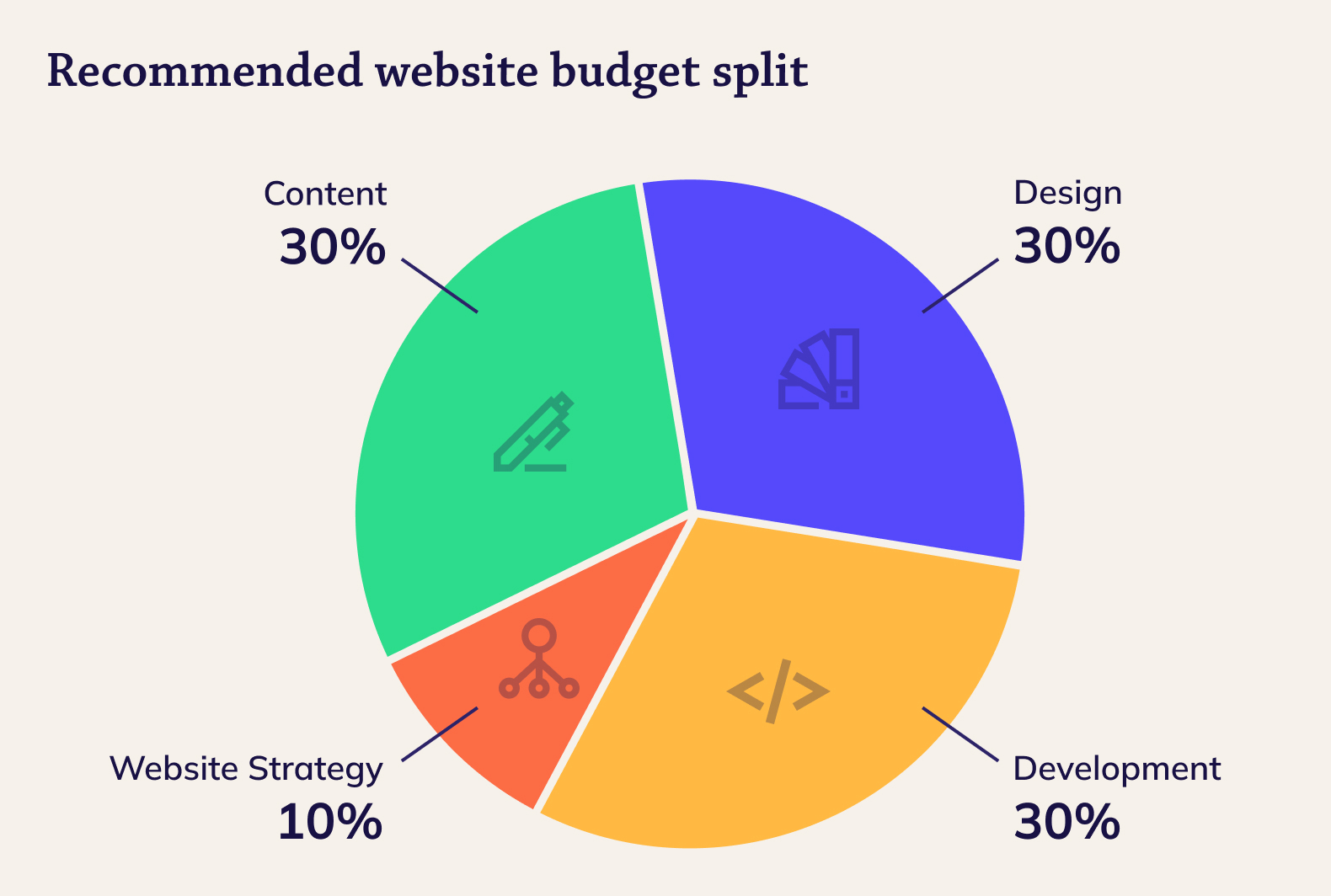A HubSpot website could cost you anything. You could spend anywhere between £10 to upwards of £1 million. In reality, it’ll cost you whatever you’re prepared to spend.
We’ve put together this blog to outline what you should invest in if you’re looking to create a marketing-leading, demand-generating HubSpot website, not just one that’s low-cost.
A powerful HubSpot website requires investment
If you’re an established business, it's a non-negotiable that you have an effective website. You should be utilising it to help you grow, so it's a great place to invest your time and money.
Why? It’s the number one way that B2B buyers choose to engage with a business. You can use your website to generate demand and build a platform for sustained growth.
Today’s purchasing environment is buyer-controlled. Your branding, website design, and content contribute to how much value a future buyer gets from you. They also impact important relationship factors like brand affinity – providing a memorable touchpoint with your audience that they remember.
Your website and its content are ideal for building an informative, helpful buyer’s journey. One that lets them discover your offering in their own time, under their control. Yet, many businesses look to minimise costs on their website, despite its importance.
It's understandable, even those who do comprehend the value can end up investing money in the wrong places. This results in a website that looks nice but doesn't provide a return on investment.
Where should you focus your HubSpot website costs?
Here’s what you should budget for when planning a website project.

Website strategy
Let’s begin with your website strategy. A website strategy positions you to create a powerful, impactful website using data and an understanding of your desired goals and outcomes.
You can create a website strategy in-house, or get support from an experienced HubSpot website agency to develop an in-depth, effective strategy. Ultimately it needs to be done. Here are the basics to cover:
- Audience – consider who will be using your website, and who you want to target. For example, research what your ideal buyer journey is. And take time to understand how your visitors want to find the information they’re looking for. When you know your audience, you’re better placed to create a website that suits the needs of your buyer. Plan how you will research this.
- Value proposition – this is a piece of information that communicates why a buyer should choose your offering. What value does your business bring, and how will that be shown on your website? Create a defined value proposition, and explore how it’ll be represented on your website.
- Redirection and migration – if you’ve got an existing website, consider the time and costs of planning and managing redirects and migration. For example, you might be migrating your website to a new CMS, like HubSpot. Do you have a website migration strategy?
- Structure and SEO – consider what search engine optimisation (SEO) best practices and keyword strategy you’ll implement. Start by creating an intuitive sitemap that balances usability and SEO. And then look at how you will align your sitemap to your keyword strategy. Learn how to use buyer intent keywords to boost B2B SEO.
Copy
The next step is to think about is the copy on your website.
Website copy is crucial – if your website doesn’t say anything, and say it well, then your visitors will struggle to understand your value. Yet, it's almost always overlooked when businesses set budgets for a new website.
- Strategic alignment – to achieve fast and effective results in B2B marketing, content and strategy must support each other. Make sure that your website pages are optimised for buyer-intent keywords and are discoverable on search engines.
- Tone of voice – your voice matters. You might be using run-of-the-mill corporate speak, or a distinctive and unique voice that’s pertinent to your brand. Whichever it is, it must be consistent throughout your website and wider content. This supports brand affinity and makes you easier to recognise, no matter what platform or medium your audience interacts with your website. Learn how to get your brand tone of voice right.
- Copy for web – a website isn’t always straightforward to write. Compelling website copy must be clear, concise, and easy to understand for your ideal audience. Populating your website pages with content isn’t just a simple copy-and-paste job from your latest product brochure. It's important to have a team that has the right expertise that can structure, write, and curate persuasive copy that’s optimised for your web pages, so your words have the most impact.
- Content – as for your content, such as your blog posts and pillar pages, ensure that it is crafted and structured to rank for attractive, informative search terms. These would be topics that are relevant to what your audience searches for and engage with. Be aware that the costs of creating effective content will depend on what content you need, what your audience expects, and the associated costs of creating it for your industry.
Design
The next step to budget for is your website design.
An effective website design enables you to meet your buyer's needs at every stage of their journey. And you want to showcase your business in a pleasing way. Lots of information on this topic advises you to purchase a theme for your website and customise it for your brand. Whilst this is an option, it doesn't create a bespoke website that is crafted to meet the needs of your buyer, combining design and brand to create a powerful experience.
- Design – creating an impactful and visually stunning website requires an experienced digital web designer. A design and creative professional can create concepts for your new website, adapt the design based on your brand, and find unique methods of displaying your website’s contents. For many businesses, this can help you stand out, so it’s worth investing in.
Blend recommends: Branding is an important part of building great brand affinity with your audience. Make sure you’ve already got a developed, suitable brand for your website before assessing your website design requirements. You need a well-defined, fit-for-purpose brand to successfully create a unique and powerful website.
- User experience (UX) – UX design is about anticipating a user's actions and creating a website journey that puts the right information in front of visitors, at the right time. Plan how you will research the ideal UX experience.
- Website accessibility – a website that's 'as accessible as possible' lets anyone, regardless of abilities, platform, or context, explore your website with ease. Make sure you have the knowledge and resources to create a website that's accessible.
Development
Website development pulls together your strategy, content and, design to provide optimal user experience and performance. There are two core elements of HubSpot website development:
- Speed and performance optimisation – good website performance is non-negotiable for user experience and ranking in search engines. Fortunately, HubSpot CMS comes with a suite of inbuilt performance tools, like automated image optimisation, code minification, and more. This means you don't require custom development or additional plugins to make these enhancements, it's built-in automatically. However, it's still crucial that you have an experienced developer that can structure your code optimally so performance doesn't slip.
- Editing experience – websites shouldn't be static, they need to evolve over time to suit your buyers' needs. Your website should be developed with an easy editing experience in mind. Although, it's important to balance editability with appropriate constraints to maintain consistency.
Read our guide to discover how to speed up your website, and understand what could be slowing it down.
HubSpot website cost
From a software perspective, the cost of a HubSpot website can range from an entry-level, free option to HubSpot Professional and HubSpot Enterprise prices. The price of the HubSpot Content Hub will depend on your business size, goals, data, and analytics requirements.
Additional costs
Whilst HubSpot Content Hub has almost everything you need for a website, built-in. There aren't included with the software:
- Domain name – there are free and paid-for services that let you register and keep a domain name. A unique domain name could cost you anywhere between £0.99 - £10.00 per year, but some popular domains can be resold at a higher value.
- DNS management – if you already have a website, you'll have a solution for managing your DNS records so there will be no additional cost. However, if you're creating a website with a new domain, you may need to add a new DNS zone, and there could be a small cost for doing so.
Considering using HubSpot CMS for your website?
If you're considering using HubSpot CMS for your website but are unsure if the platform is right for you, book a demo with one of our experts.
Our CMS specialist will guide you through:
- An overview of HubSpot CMS and Content Hub's key features
- A live demonstration of the website editing experience
- A showcase of the AI tools available in Content Hub
If you have any questions about the platform, we'll answer them for you, enabling you to make an informed decision.

